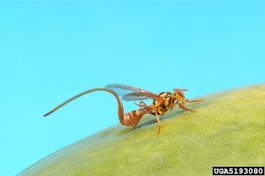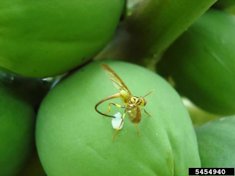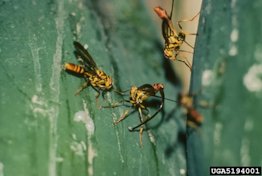Papaya Fruit Fly From the Entomology and Nematology Department, Florida Cooperative Extension Service, Institute of Food and Agricultural Sciences, University of Florida Toxotrypana curvicauda Gerstaecker These are sometimes called wasps, because of the long ovipositor of the female fly as well as similarities in size and color. This long egg-laying organ, which is as long as the body proper, penetrates the flesh of the fruit and enters the seed cavity. Eggs are usually laid in small fruit, about two to three inches in diameter, but they may be deposited in smaller and larger fruit, especially during high populations of the fly. 1 The larvae, which are small legless maggots, feed on the seed and interior parts of the fruit. When the larvae become mature, they emerge from the fruit, drop to the ground beneath the plant and pupate just below the soil surface. After about two to four weeks the flies emerge to mate and seek fruit in which to lay eggs. 1 Fruit infected with papaya fruit fly larvae will turn yellow and drop from the tree prematurely. Damage levels in Florida fluctuate between 2 and 30% of fruits infested during the spring-summer season. 2 Prevention of egg-laying is the key to controlling papaya fruit fly. It is necessary to kill the adult female before she deposits eggs in the fruit. Control of the fly may be achieved by mechanical protection such as the use of paper bags. Each fruit may be enclosed in a 3-5 pound size bag tied around the fruit stem to hold the bag. Newspaper, one-half sheet (about 12-15 inches in size), may be rolled to enclose the fruit, then tied around the fruit stem, and also the free end. Bagging should begin when the fruit is small, shortly after the flower parts have fallen. This method of control is more adapted to small (1 to 25 plants) than to large (one-fourth acre or more) plantings. Although bagging the fruit is the most certain method of control, it is a laborious process and requires attention at regular intervals (10 to 14 days) to keep the young fruit covered. Also, this procedure will injure some of the fruit unless handled carefully. 1
Sanitation is also quite important in the control of the papaya fruit fly. All dropped and prematurely ripe fruit, as well as infested young fruit, must be destroyed in order to prevent the larvae from developing into adults. 2 Very little research has been done on the biological control of papaya fruit fly, considering its economic importance. One parasitic wasp, in particular, Doryctobracon toxotrypanae Marsh (Hymenoptera: Braconidae), from southern Mexico and Costa Rica, may have potential for control. 2 Pheromone lures and traps are a critical part of dealing with fruit fly infestations for monitoring populations, measuring distribution, and acquiring control or eradication. Research in Miami and Gainesville, Florida has resulted in the development of a pheromone lure and functional trap for this species. Studies are presently being performed to test female pheromone lures with the addition of host odor chemicals in order to increase the attraction of flies and to improve its performance in competition with males. 2 Other control measures have also been suggested for possible research in the future such as papaya fruit without seeds. Due to the strong dependence of larval feeding on the seeds as an early food source, a seedless papaya variety could be explored. For similar reasons, thicker pulp could possibly provide enough resistance to hinder the ovipositor from successfully depositing eggs. Another suggestion has been to look for varieties of papaya with higher levels of chemicals that are toxic to the larvae. 2 Back to Papaya Pests Page |
||||||
| Bibliography 1 Pena, Jorge E., and Freddie A. Johnson. "Insect Management in Papaya." Entomology and Nematology Dept., UF/IFAS Extension, EENY-542, Original pub. Oct. 1993 Revised Aug. 2006, Archived, AskIFAS, edis.ifas.ufl.edu. Accessed 31 March 2014. 2 Lane Selman, H., et al. "Papaya Fruit Fly (suggested common name), Toxotrypana curvicauda Gerstaecker (Insecta: Diptera: Tephritidae)." Featured Creatures, Entomology and Nematology Dept., UF/IFAS Extension, EENY-021 (IN148), Original pub. Mar. 2001, Revised Apr. 2015 and May 2021, AskIFAS, edis.ifas.ufl.edu/in148. Accessed 2 Feb. 2017, 9 Aug. 2020, 24 Feb. 2022. Photographs Fig. 1 Lotz, Jeffrey W. "Papaya Fruit Fly Toxotrypana curvicauda Gerstaecker, adult." University of Georgia, 2007, Updated 2009, Bugwood.org, (CC BY-NC 3.0 US), bugwood.org. Accessed 12 Feb. 2017. Fig. 2 Fernández, Daniela Jiménez. "Papaya Fruit Fly Toxotrypana curvicauda Gerstaecker." 2012, Updated 2013, Bugwood.org, (CC BY-NC 3.0 US), bugwood.org. Accessed 12 Feb. 2017. Fig. 3 "Papaya Fruit Fly Toxotrypana curvicauda Gerstaecker." Florida Division of Plant Industry Archive, Florida Department of Agriculture and Consumer Services, 2007, Updated 2009, Bugwood.org, (CC BY-NC 3.0 US), bugwood.org. Accessed 12 Feb. 2017. Published Feb. 2014 LR. Last update 24 Feb. 2022 LR |
||||||



